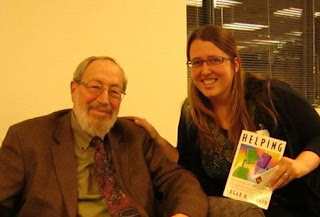I exited the Lakeshore Drive off-ramp at Navy Pier, yesterday, to come head-to-head with a blue police barricade. Something was amiss with police cars zooming the wrong way on a one-way street. No lanes of traffic could proceed. It turns out that the Vice President was making me late.
As we watched the traffic light turn from green to red to green again, some cars behind me began to howl. I could hear the exasperation behind the blaring horns: “The light is green, you idiots! Why aren’t you moving?” It was clear to the rest of us that we were going nowhere and that patience was needed. (I put the car in park, rolled down the windows and seat-danced to the radio.) I watched around me as other drivers just shook their head in response to the blaring horns. The signs were everywhere – from the police barricade and cops on every street corner to the speeding police cars passing in front of us – there was a legitimate reason we were not budging an inch. Impatience and aggression was futile.
But I wonder… how many times does this happen in our organizations? When we, as leaders, don’t have clear visibility to the front lines, do we get fed up with inaction and overtly make it known? Are we oblivious to the barricades ahead that are inhibiting our people from moving forward? Do we simply use the “horn tactic” – get louder and more demanding – as the front-line employees stare helplessly at the blockade before them?
As I seat-danced to my radio, I reflected on the scenario around me and identified three horn-less lessons for dealing with a standstill:
Just like that, Vice President Biden sped by amid yet more police cars. Someone up top gave the orders for the police to remove the barricades, and we were set free. And what do you know? When the obstacle was removed from our path, we moved forward on our own accord. No horns needed.
As we watched the traffic light turn from green to red to green again, some cars behind me began to howl. I could hear the exasperation behind the blaring horns: “The light is green, you idiots! Why aren’t you moving?” It was clear to the rest of us that we were going nowhere and that patience was needed. (I put the car in park, rolled down the windows and seat-danced to the radio.) I watched around me as other drivers just shook their head in response to the blaring horns. The signs were everywhere – from the police barricade and cops on every street corner to the speeding police cars passing in front of us – there was a legitimate reason we were not budging an inch. Impatience and aggression was futile.
But I wonder… how many times does this happen in our organizations? When we, as leaders, don’t have clear visibility to the front lines, do we get fed up with inaction and overtly make it known? Are we oblivious to the barricades ahead that are inhibiting our people from moving forward? Do we simply use the “horn tactic” – get louder and more demanding – as the front-line employees stare helplessly at the blockade before them?
As I seat-danced to my radio, I reflected on the scenario around me and identified three horn-less lessons for dealing with a standstill:
- Don’t jump to conclusions - Especially when the conclusion is, “Everybody but me is an idiot.”
- Remember that patience truly is warranted - Things may not be moving as quickly as you need them to, but losing your cool won’t help.
- Focus your efforts on unearthing the root cause - Examine the surrounding systems. Look for clues. Identify the source of the problem. If you have the power to move the barricade, then by all means, do.
Just like that, Vice President Biden sped by amid yet more police cars. Someone up top gave the orders for the police to remove the barricades, and we were set free. And what do you know? When the obstacle was removed from our path, we moved forward on our own accord. No horns needed.





